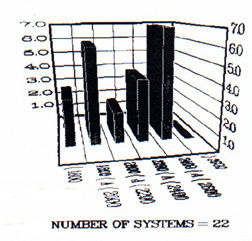
ECOLOGICAL PARAMETERS AFFECTING THE SETTLEMENT'S CHOICE IN ALPINE MARMOT (Marmota marmota)
Macchi E.*, Bassano B.*, Durio P.*, Tarantola M.* & Vila A.#
* Università di Torino, Dip. di Produzioni Animali, Epidemiologia ed Ecologia, V. Nizza 52, 1-10126 - Torino.
# Parco Naturale Orsiera-Rocciavré
Abstract - The ecological characteristics of 22 colonies of Alpine Marmot (Marmota marmota), in the 0rsiera-Rocciavrè Natural Park, has been analysed, during 1990 and 1991.
Tire burrows' density (per 100 m2) has been calculated and correlated with the number of animals seen and other territorial variables (altitude and site conformation).
In all burrow systems the dimension of each burrow (height, width and area) has been evaluated.
The marmot density has been calculated in 3 sample areas.
INTRODUCTION
Many are the environmental factors conditioning the settlement of Alpine Marmot (Marmota marmota) colony in a given place. Among them the following parameters were analized by different Authors: exposition, altitude, slope and physiognomic composition of the territory (Couturier, 1964; Huber, 1978;
Janeau e Mann, 1988; Lenti, 1988; Ferri et al., 1988; Grimond e Bassano, 1991).
The conformation of the area and the morphological and structural characteristics of the substratum can also affect the anti-predator strategies of the Alpine Marmot.
Has been proved that living in open habitats brings many species of rodents to live in locally dense populations and to develop collective-communal alarm systems (Wilson, 1979). The choice of the alpine Marmot for open areas and high-altitude grassland is related to the wider visibility that they give of approaching areal or terrestrial predators (Pigozzi, 1989). Expression of an anti-predator tactics can be considered the avoidance of sites with long-trunked arboreal vegetation as well as the building of complex burrows systems in which principal, secondary and temporal or escape burrows are distinguished (Zelenka, 1965; Armitage, 1962; Merriam, 1971; Pigozzi, 1984; Durio et al., 1987).
The density of the latter type, along with environmental factors as vegetation height and the spatial distribution of the sighting-points, affect the Marmot's behaviour (Pigozzi, 1989). The density of the marmot burrows in relation with the areas used are analyzed in the present paper.
METHODS AND STUDY AREA
During one year of study (spring-summer 1991) the ecological parameters of the sites utilized by Marmota marmota, in the southern side of the Orsiera-Rocciavré massif (Western Italian Alps, Natural Park Orsiera-Rocciavré, Torino province) were examined. 22 burrows systems were considered, located in different areas of the Park and the dimensions of 642 burrows were taken.
The den density (number of active burrows per m2) was calculated measuring the surface of the polygon delimited by the outermost used burrows. According to other researchers (Pigozzi, 1984; Bopp, 1956; Grimod et al., 1991) the following features of the burrows were taken in to account: height, width, inclination and area (obtained multiplying height by width).
RESULTS
Marmots settlements were found between 1650 and 2800 m a.s.l. Most of the den systems (52% out of 22 systems - Fig. 1) were above the timberline between 2200 and 2600 m a.s.l. Slopes facing the southern quadrants were absolutely preferred (71.3% - Fig. 2): the most frequently used were those facing south-east (45.5 %) and south-west (22.7%) (Fig. 2).
The openings of the dens (n=596) were oriented in the same way of the slopes: southern orientation was dominant (55.0% - Fig. 3). It is noteworthy the high number of opening facing East. The great majority of the burrows is digger in meadows or beneath small rocks (62.9% - Fig. 4). Few are, in our sample, the burrows in accumulations of rocks; it may be by the fact that such environmental is scarce in the study area. A medium of the slopes (10° to 30° - Fig. 5) seems to be a binding element in the choice of the site. Also the first stretch of the den (the first 50 cm of the burrow) almost always a medium - strong inclination (10° to 30° and more - Fig. 6). Of 642 openings we found the mean height (h=18.5� 3.5 sd) and the mean width (w= 25.0 �4.7 sd) and their ratio (area = 423.8 � 124.3).It is possible to note that the value of the width is generally bigger than that of the height. In systems the area occupied by the marmots was calculated as the area delimited by the outermost burrows used by each family group. The mean used area is 118.6 m2 (�38.1 thus the average den density is 0.86/100 m2. The number of burrow in each den system the area occupied are both positively correlated (r=0.55; t= 2.5;P=0.025 and r= 0.40; t=1.8; P=0.05 respectively) with the number of marmots, calculated as the maximum number of animals seen at the same time during consecutive visits. In the same way the total used area increases with the number of burrows of the den system (r= 0.85; t= 7; P= 0.01). No correlation was found between the number of marmots and the density of the burrows (number of burrows/100 m2). Thus we wanted to analyse if the density could he affected by elements external to the population and in particular by the conformation of the territory occupied by the marmots. Three different types of site were distinguished (Fig. 7):
- Type "A": Den systems located in closed areas, at the bottom of narrow gorges, between rock faces or between a rock face and a wood;
- Type "B": Den systems located at the foot of a rock wall or at the edge of a wood;
- Type "C": Den systems located in open areas, i. e. high altitude alpine prairies.
Comparing the density of burrows in type "A" and type "C" a statistically significant difference was found (U=2; P<0.05, Mann-Withney U-test).
CONCLUSIONS
From our study emerges that the den is an element of great importance for the strategy of the marmot's use of the territory. The burrow density stays almost the same in similar environments. Where environmental elements and the conformation of the ground reduce the chances of detection of an approaching predator i. e. a dangerous situation, the density of burrows is high. This confirms than the particular arrangement of the marmot dens is due to a precise defence strategy from both flying or ground predators.
CARATTERISTICHE ECOLOGICHE DEGLI INSEDIAMENTI DI MARMOTTA ALPINA (Marmota marmota)
Macchi E.*, Bassano B.*, Durio P.*, Tarantola M.* & Vila A.#
* Università di Torino, Dip. di Produzioni Animali, Epidemiologia ed Ecologia, V. Nizza 52, 1-10126 - Torino.
# Parco Naturale Orsiera-Rocciavré
Introduzione
Diversi sono i fattori ambientali che condizionano l'insediamento di una colonia di Marmotta Alpina (Marmota marmota). Tra questi sono stati analizzati, da Autori diversi, parametri come l'esposizione, l'altitudine, l'inclinazione dei versanti e la composizione fisionomica dei territori (Couturier, 1964; Huber, 1978; Janeau e Mann, 1988; Lenti, 1988; Ferri et al., 1988; Grimod e Bassano, 1991). La conformazione del suolo e le carattersitiche morfologiche e strutturali del substrato sono in grado di influenzare anche le strategie anti-predatore della Marmotta alpina. È dimostrato infatti che la vita in habitat esposti condiziona la formazione, in molte specie di roditori, di dense popolazioni locali e la sviluppo di sistemi d'allarme collettivo-comunitari (Wilson, 1979). La scelta da parte della Marmotta alpina di terreni aperti e di praterie di alta quota è legata alla maggior visibilità che essi offrono nei confronti dell'approccio dei predatori di aria e di terra (Pigozzi, 1989). Possono essere considerati espressione di una tattica anti-predatore anche comportamenti come il mancato utilizzo di ambienti con vegetazione arborea ad alto fusto e la costruzione di complessi sistemi di tana, in cui si distinguono tane principali e secondarie e tane di rifugio temporaneo o di fuga (Zelenka, 1965; Armitage, 1962; Merriam, 1971; Pigozzi, 1984; Durio et al., 1987). La densità di queste ultime, insieme ad altri fattori ambientali, come l'altezza della vegetazione e la distribuzione spaziale dei punti di avvistamento, influenzano il comportamento della Marmotta (Pigozzi, 1989). La densità di tane di Marmotta, in relazione agli ambienti utilizzati, viene analizzata nel presente lavoro.
Metodi - Area di studio
In un anno di indagini (primavera-estate 1991), si sono esaminate le caratteristiche ambientali dei siti utilizzati da Marmota marmota, nel versante Sud del massiccio montuoso dell'Orsiera-Rocciavrè, Alpi occidentali italiane (Parco Naturale Orsiera-Rocciavrè, provincia di Torino). Sono stati presi in esame 22 sistemi di tana, localizzati in diversi settori del Parco e rilevate le dimensioni di n. 642 aperture di tane. La densità di tane (numero di tane attive per m2) si è ottenuta calcolando l'area del poligono delimitato dalle più estreme aperture di tana utilizzate. In accorda con altri Autori (Pigozzi, 1984; Bopp, 1956; Grimod et al., 1991) si sono rilevate le seguenti caratteristiche delle aperture di tana: altezza, larghezza, inclinazione e area (valore quest'ultimo ottenuto moltiplicando l'altezza per la larghezza).
Risultati
La presenza di insediamenti di Marmotta si é rilevata a quote comprese tra i 1650 ed i 2800 m.s.l.. La maggior parte dei sistemi di tana (52%, su 22 sistemi - Fig. 1) é risultata essere localizzata al di sopra del limite superiore della vegetazione arborea, a quote comprese tra i 2200 ed i 2600 m.s.l. Dal punto di vista dell'esposizione, i quadranti a Sud sono assolutamente prevalenti (71,3% - Fig. 2): i versanti più utilizzati sono quelli ad esposizione Sud-Est (45,5% ) e Sud-Ovest (22,7%) (Fig. 2).
L'orientamento delle aperture di tane (n= 596 tane) corrisponde sostanzialmente a quelle dei versanti: la localizzazione a Sud é prevalente (55,0% - Fig. 3). È tuttavia da rilevare un elavato numero di tane aperte verso Est. La maggior parte delle tane viene scavata su prato o al di sotto di piccoli massi (62, 9% - Fig. 4). Le localizzazioni in pietraia sono, nel nostro campione, assai ridotte, si ritiene a causa della scarsa presenza di questa tipologia ambientale nelle aree da noi indagate. L'inclinazione, media e forte (da 10° e 30°- Fig. 5), dei versanti sembra essere elemento vincolante la scelta del sito da parte della Marmotta. Anche il primo tratto dei cunicoli (primi 50 cm in profondità) è pressocché costantemente in pendenza, media o forte (tra i 10° ed i 30° ed oltre - Fig. 6). Per un campione di 642 aperture i tana si é rilevato il valore medio di altezza (h= 18,5 � 3,5 d.s. ) e larghezza (l= 25,0 � 4 d.s.) e del loro rapporto (area=423,8 � 124,3). Possiamo rilevare come il valore della larghezza sia mediamente superiore rispetto a quello dell'altezza. In 22 sistemi di tana è stata valutata l'estensione del territorio occupato dalle marmotte, delimitato dalle più estreme aperture di tana utilizzate da ogni singola famiglia. La superficie media occupata é di 118,6 m2 (�38,1 d.s ): ne risulta una densità media di 0,86 tane per 100 m2. Il numero di tane persistema e la superficie occupata sono positivamente correlati (rispettivamente, r= 0,55; t= 2,5; P= 0,025 e r= 0,40; t= 1,8; P=0,05) con il numero di marmotte presenti, calcolato come numero massimo di animali visti contemporaneamente al di fuori della tana, nel corso di successivi sopralluoghi. Nello stesso modo, all'aumento del numero di tane par sistema corrisponde un aumento della superficie totale occupata (r=0,85; t=7; P=0,01). Non è emersa invece nessuna correlazione tra il numero di marmotte presenti e la densità di tane (numero di tane per 100 m2).
Si é voluto percio analizzare se tale densità potesse essere influenzata da elementi esterni alla popolazione, in particolare dalla conformazione del territorio occupato. Si sono cosi distinti tre diversi tipi di localizzazione (Fig. 7):
- tipo "A ": sistemi di tane localizzati in aree chiuse, situati al fondo di canali stretti, tra pareti di roccia o tra pareti e limite del bosco;
- tipo "B ": sistemi posti alla base di una parete di roccia o al limite di un bosco;
- tipo "C": sistemi siti su terreni aperti, tipo prateria alpina di alta quota.
Si é rilevata una differenza statisticamente significativa tra la densità di tane nei sistemi di tipo "A " rispetto a quelli di tipo "C" (U=2; P<0,05, Mann- Withney U-test).
Conclusioni
Da quanto osservato emerge che la tana è un elemento di fondamentale importanza nelle strategie di uso del territorio da parte della Marmotta. La densità di tane rimane pressocchè costante in ambienti simili. Là dove gli elementi ambientali e la conformazione del sito determinano una situazione di minore visibilità nei confronti dell'avvicinarsi di predatori e quindi di maggior pericolo, la densità delle tane é maggiore. Questo conferma che la particolare disposizione delle tane di Marmotta é frutto di una precisa strategia di difesa nei confronti dei predatori di aria e di terra. Il prosieguo delle ricerche é sotteso anche all'ulteriore verifica di questa ipotesi.
Fig. 1: Altitude of burrows systems

Fig. 2: Exposure of burrows systems %
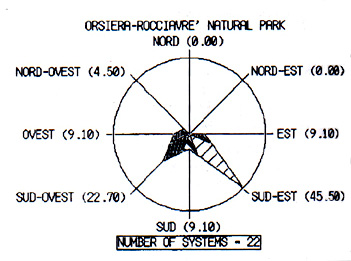
Fig. 3: Exposure of marmot burrows %
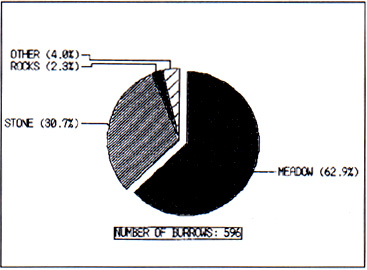
Fig. 4: Localization of marmot burrows
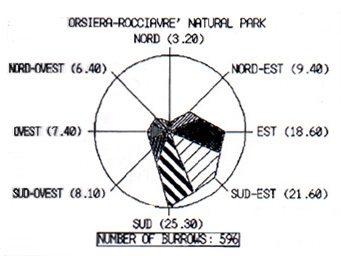
Fig.5: Slope of the ground
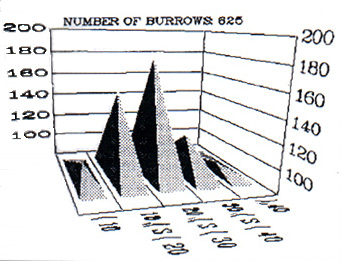
Fig. 6: Slope of the burrows
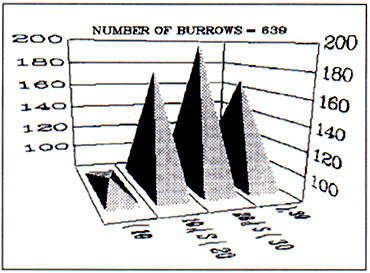
Fig. 7: Aspect of the inhabited area - systems of burrows

The density of burrows (per 100 m2) in "A" systems is significantly greater than that in "C" systems (U=2; P<0,05; Mann-Whitney U-test)
retour/back
REFERENCES
ARMITAGE K.B., 1962 - Social behaviour of a colony of the yellow-bellied marmot. Anim. Behaviour, 10: 319-331.
BOPP P., 1956 - Zur topographie eines kolonialterritoriums bel murmeltieren. Revue Suisse, 63, 2: 255-261.
COUTURIER M., 1964 - La Marmotte des Alpes. In Le Gibier des montagnes française. Arthaud Ed.: 137-
165.
DURIO P., BASSANO B., PERRONE A., 1987 - Le tane della Marmotta. Atti 1° Incontro di Studio sulla Marmotta Alpina. Coll. Scient. P.N-G-P-, Torino: 25-31.
TERRI M., PIGOZZI G., SALA L., SOLA C., SPAMPANATO A., TARANTINO S., TONGIORGI P., TOSI C., 1988 - Primi risultati di una ricerca sulla popolazione di Marmota marmota del crinale appenninico tosco-emiliano. Atti 1° Conv. Naz. Biologi della Selv. Suppl. Ric. Biot. Selv., XIV: 339-349.
GRIMOD S, BASSANO B., 1991 - La Marmotta (Marmota marmota) in Valle d'Aosta: ecologia e distribuzione. Reg. Aut. Valle d'Aosta, Il 7 pp.
HUBER W., 1978 - La Marmotte des Alpes. O.N.C., Paris, 30 pp.
JANEAU G., MANN C., 1988 - Organisation sociale et l'occupation de l'espace chez la Marmotte des Alpes. Atti II° Incontro di Studio sulla Marmotta Alpina, Coll. Scient. P-N-G-P-,Torino: 25-34.
LENTI BOERO D., 1988 - Distribuzione degli insediamenti e stima della densità di Marmotta Alpina (Marmota marmota): metodi di indagine per zone campione. Suppl. Ric. Biol. Selv., XIV: 253-264.
MERRIAM H.G., 1971 - Woodchuck burrow distribution and related movement patterns. J. Mammal., 52, 4: 732-746.
PIGOZZI G., 1984 - The den system of Alpine Marmot (Marmota marmota marmota) in the National Park of Stelvio, Northern Italy. Z. für Sàugetierrkunde, 49: 13-21.
PIGOZZI G., 1989 - Predation on Alpine marmot, Marmota marmota (L.), by golden eagle, Aquila chrysaetos (L).
WILSON E., 1979 - Sociobiologia. Zanichelli, Bologna.
ZELENKA G., 1965 - Observation sur l'ecologie de la Marmotte des Alpes. La Terre et la Vie, 19: 238-256.
Tornare index / back contents